XFX Type 01 Bravo Case Review
by E. Fylladitakis on May 16, 2014 6:00 AM EST- Posted in
- Cases/Cooling/PSUs
- XFX
- mid-tower
- Case
Test Setup
Professional testing requires the emulation of real-world situations but with repeatable results; thus, a perfectly controllable test setup and environment are required, especially for comparable results. Testing the thermal performance of any case with a typical real-world setup technically limits the comparability of the results to this setup alone, as an active system interacts with its environment and the change of a single component alters (albeit in small ways) myriads of variables. In order to eliminate such factors, we developed synthetic loads that emulate the thermal output of real systems that are passive, steady and quantifiable.
Our thermal testing now displays the thermal capabilities of the case alone, as if it must deal with the entire thermal load by itself, regardless of the system that might be installed inside it. Laboratory data loggers are used to monitor the PT100 sensors and control the safety relays, which are fully accessible via our custom software. Three such loads have been developed, and today we'll be using the ATX load.
The ATX version simulates a 200W CPU, 50W VRM, 30W RAM and 4 × 120W GFX card thermal load; additionally, three 3.5" HDD dummy loads are also present that each convert 30W of electrical power to thermal, bringing the total thermal load of the ATX test setup up to 850W. As such, the thermal load is immense and only the best of cases will be able to handle it for more than a few minutes. We also test with a thermal load of 400W, with all of the aforementioned components except the HDD drives at about 42% power, which is more suitable for the majority of cases.
Thermal testing is performed with all of the case's stock fans operating at maximum speed. Standard noise testing is performed with a background noise level of 30.4dB(A). Advanced noise testing is also being performed, in order to assess the ability of the case to dampen the noise of the components installed inside. This includes the installation of two noise-generating sources (strong fans) inside the case, one positioned approximately over the first expansion slot and one over the CPU area, which generate ≈ 44.2 dB(A) when unobstructed. During the advanced noise test, all stock cooling options of the case are entirely disabled.
Results and discussion
Unfortuantely, the thermal performance of the XFX Type 01 is rather mediocre. We cannot deny the fact that we expected more from a case with lots of ventilation and a 200 mm fan installed, yet the Type 01 Bravo can hardly compete with mid-tower cases of similar internal proportions. After all, the Type 01 Bravo is, as far as dimensions are concerned, a typical mid-tower case with plastics that add a lot of bulk. When compared to a high performance (and significantly more expensive) gaming case, the XFX Type 01 Bravo falls behind in terms of thermal performance. To illustrate this, we have created additional graphs showing other cases that we have tested using our new procedures. We are focusing on the two hottest components for these charts, the CPU and GPU loads.
The other side of the story is that the stock cooling fans of the XFX Type 01 Bravo are very weak. Although this obviously has a great effect on thermal performance, it also means that the XFX Type 01 Bravo generates very little noise. Even with its fans running at maximum speed, the XFX Type 01 Bravo generated levels of noise barely perceptible from one meter away.
Considering the fact that the design of this case is not really meant to dampen the noise of the system, the stock cooling system of the XFX Type 01 Bravo may not be powerful but it certainly is efficient considering the small amount of noise it generates. When additional noise sources are present, the acoustic performance of the XFX Type 01 Bravo is mediocre, as the design of this case (and most cases optimized for airflow) has virtually zero noise-dampening capabilities.


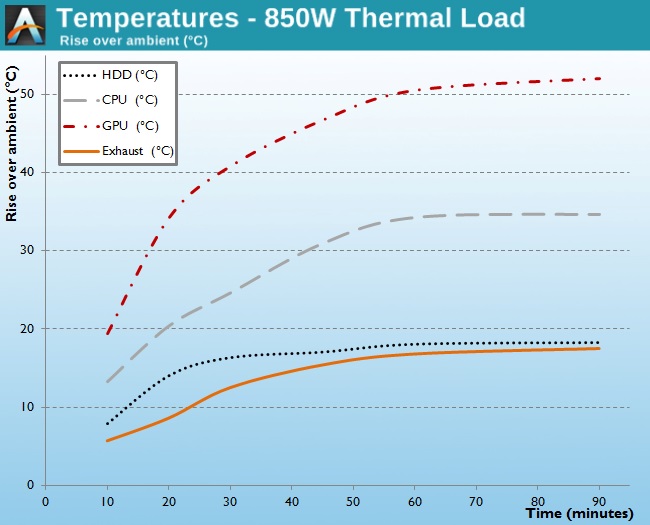
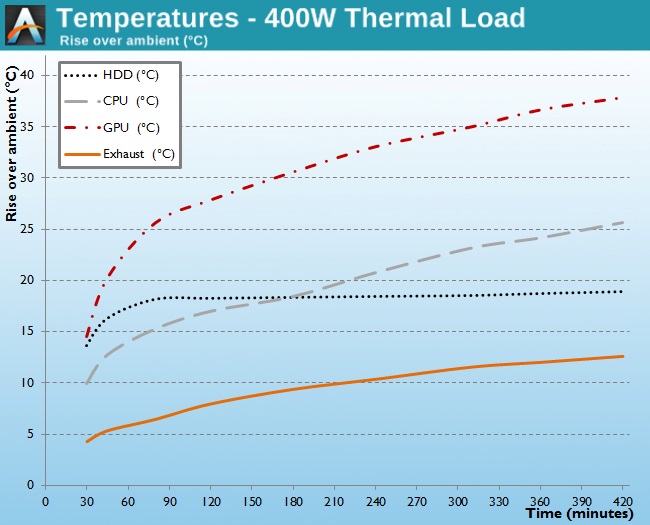
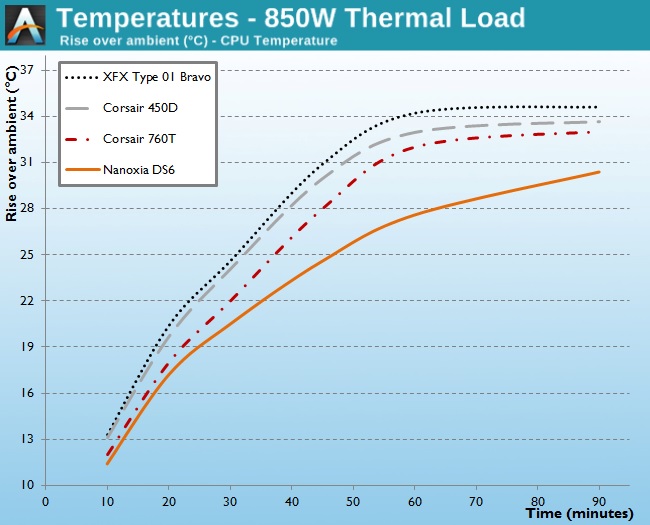
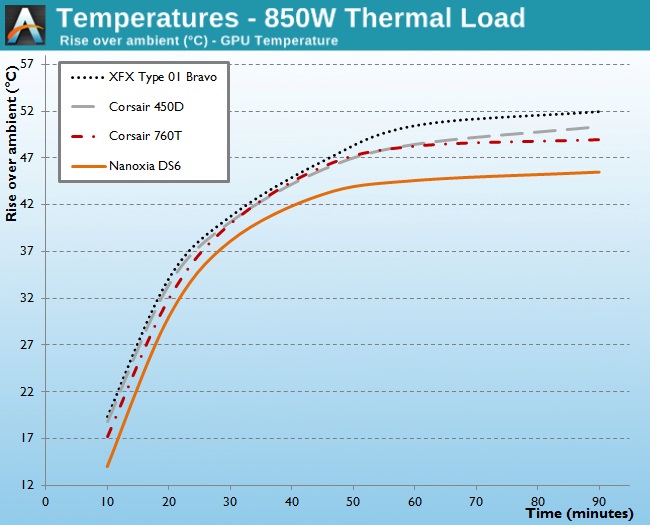
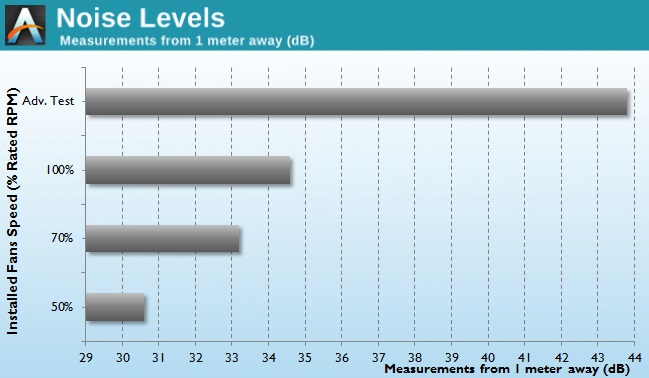








28 Comments
View All Comments
dstarr3 - Friday, May 16, 2014 - link
I've noticed that you rarely include full photos of the cases you review on the first page. I'd really appreciate it if you'd change that, as, no offense, I'd really rather not read the review of a case that I'd never buy based on looks already.E.Fyll - Friday, May 16, 2014 - link
Good point. The appearance after all is the most important factor when selecting a case. This can be arranged.dstarr3 - Monday, May 19, 2014 - link
Thanks. :-)Haravikk - Saturday, May 17, 2014 - link
This is one ugly, over-sized case! While I admire an effort to go for a unique look, I don't think the horizontal bars are attractive at all; maybe if the front of the case weren't a uniform flat-surface it might look better. I also think that the main body should be in a different colour, one of the pictures looks like there is a silver/grey bodied version which might look a bit better. Even so, the plastic top "handles" are incredibly disappointing; it wouldn't take much to make them strong enough for carrying (just needs some curved and reinforced steel through it that fits securely onto the chassis) which strikes me as a huge failure on attention to detail.The size is also bewildering; personally I think the case could have looked a lot better with a concave front (curving inwards at middle height), sticking out enough at the top for an optical drive, and at the bottom for housing two (3.5") to four (2.5") hard drives down in front of the PSU. This would have improved the visual appearance incredibly, at which point the horizontal bars could even look good, while giving good airflow. Maybe even flatten off the curve toward the middle to give a space for a 5.25" bay fan controller (but not a full 5.25" bay) since those are fairly common in gaming cases.
Being able to fit a 200mm front fan is nice, but personally I'd be fine with a slimmer case and two 140mm fans instead, especially since that would give you more airflow to both the GPU(s) and CPU as standard.
The main plus points seems to be the excellent cable routing spaces and the ability to fit three side fans (or a huge radiator), but I'm not sure how much those are worth given the other problems.
edmoncu - Sunday, May 18, 2014 - link
If not for the huge XFX logo, this would've been one ugly case!poordirtfarmer2 - Sunday, May 18, 2014 - link
Agreed! The thing looks like the engine case of my toy tractor when I was a kid. And a rounded top - heck, where's the cat going to sit?masterpine - Sunday, May 18, 2014 - link
This thing needs to be taken out behind the barn and shot. I know style is subjective, but quality seems to have been a low priority which is pretty poor for this price point.hassaqbear - Sunday, May 18, 2014 - link
Front reminds me of the xps 720 dell